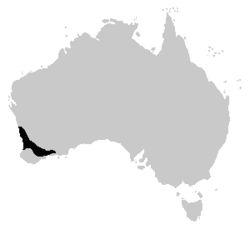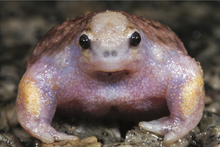Biology:Myobatrachus
| Turtle frog | |
|---|---|

| |
| Scientific classification Error creating thumbnail: Unable to save thumbnail to destination
| |
| Domain: | Eukaryota |
| Kingdom: | Animalia |
| Phylum: | Chordata |
| Class: | Amphibia |
| Order: | Anura |
| Family: | Myobatrachidae |
| Genus: | Myobatrachus Schlegel in J. E. Gray, 1841 or 1850 |
| Species: | M. gouldii
|
| Binomial name | |
| Myobatrachus gouldii (Gray, 1841)
| |

| |
| Range of turtle frog | |
Myobatrachus is a genus of frogs found in Western Australia. It is monotypic, being represented by the single species, Myobatrachus gouldii, also known as the turtle frog. It has a small head, short limbs, and a round body, up to 45 millimetres (1.8 in) long.[2]
Habitat
The turtle frog is found in between Geraldton and Fitzgerald River in the Perth region, Western Australia.[3] This area is mainly semi-arid, so the frogs have adapted to suit this region. They have developed short muscular limbs to help them dig into the sand but, unlike most frogs, they dig forward, like a turtle. They feed on termites so the adaptation of the muscular limbs is useful when trying to penetrate a termite mound. They do not need to live near standing pools of water, as they undergo the entire metamorphosis stage within their eggs. This means that they leave their eggs fully formed, skipping the tadpole stage. Their closest relatives, among the few who share most of the turtle frog's traits, are sandhill frogs and forest toadlets.[citation needed]
Mating
Mating behaviour begins with the male frog calling. In the Perth region, this calling behaviour typically begins after summer rainfall; however, calling has been recorded as early as July in populations found further inland. When a pair of turtle frogs select each other as mates, they retire to the base of their burrow. Burrows may be as much as 1.3 metres (4 ft 3 in) deep. Breeding takes place within the burrow several months later. When the females lay eggs, they lay up to 50, and each can measure 7.5 millimetres (0.30 in) in diameter.
References
- ↑ IUCN SSC Amphibian Specialist Group (2022). "Myobatrachus gouldii". IUCN Red List of Threatened Species 2022: e.T41171A78444058. doi:10.2305/IUCN.UK.2022-2.RLTS.T41171A78444058.en. https://www.iucnredlist.org/species/41171/78444058. Retrieved 24 May 2023.
- ↑ "Australian Frog Database: Myobatrachus gouldii". Frogs Australia Network. 2005-02-23. http://frogsaustralia.net.au/frogs/display.cfm?frog_id=52.
- ↑ "FrogWatch :: Turtle Frog". Western Australia Museum. http://museum.wa.gov.au/explore/frogwatch/frogs/turtle-frog.
External links
Wikidata ☰ Q11845745 entry
 |



